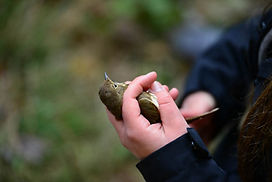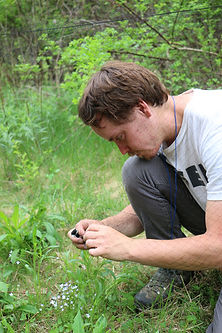Hogback Mountain Conservation Association
Route 9, Marlboro, Vermont
Preserving a Mountain Treasure

UMass Study Shows Hogback Hosts High Priority Birds
Nine of the twelve bird species identified by Audubon Vermont as being "high priority for protection" were found on Hogback in fall 2015. Researchers from the University of Massachusetts spent six weeks on the mountain from late August to early October, netting birds as part of a study of migratory song bird land use patterns. Selected birds were outfitted with nanotransmitters before being released. A network of nine receiving antennas spread up and down the Connecticut River Valley captured data on the exact locations where the birds stopped as they continued their fall migrations. The study isn't complete yet, but the researchers recently shared with HMCA the list of birds that were documented on Hogback.
A total of 443 birds were netted and released. The bird netted most often was the Magnolia Warbler (53), followed by the Black-capped Chickadee (48), Common Yellowthroat (41), Black-throated Blue Warbler (40) and Black-throated Green Warbler (39). Over a dozen species were represented only once in the list. They even netted a hawk! Wow, calming that one down enough to ease it out of the mist net must have been a challenge!
The nine "high priority" species that
visited Hogback included:
American Woodcock
Black-throated Blue Warbler
Black-throated Green Warbler
Blue-headed Vireo
Canada Warbler
Chestnut-sided Warbler
Veery
White-throated Sparrow
Wood Thrush
Not found:
Eastern Wood-Pewee
Scarlet Tanager
Yellow-Bellied Sapsucker

Learn more about Audubon Vermont's list of birds designated "high priority for protection," which they call "the Birder's Dozen" by clicking the button.



In fall 2015, UMass researchers demonstrated bird banding techniques for a group of Hogback fans.
UMass Migratory Songbird Study
Fall 2015 on Hogback
Researchers from the University of Massachusetts Amherst will be doing field work on Hogback this fall as part of a study titled "Modeling Migratory Landbird Stopover Habitat Using Nanotags." In spring of 2015, they installed a receiving antenna at the top of the former Meadow ski slope, where HMCA volunteers have been working to generate early successional habitat (ESH). The antenna is one of a network of nine situated through the Connecticut River Valley. By netting migratory songbirds and outfitting them with transmitters, the researchers will be able to collect detailed data from the receiving antennas about where the birds stop to feed and rest, how long they stay, what times of day they move, and other information. This fall, to capture data from the southward migration, they will be netting birds at Hogback on most weekday mornings. Take a walk up the Tower Trail some morning and say hello to Aaron and Kayla, the primary field researchers.



When the researchers aren't on site, they furl the mist nets so that no bird is accidentally trapped. When they are collecting data, the researchers visit each net every 30 minutes. Every bird that is caught is documented and given an ankle band, but only target species are outfitted with the transmitters.

Hogback Hosts Bird Migration Study
Field Trip to Observe Bird Banding
HMCA hosted a trip to Hadley, MA on May 12, 2015 to visit the site where researchers are outfitting migrating songbirds with nanotransmitters. (For an introduction to this research project, see the box below.) Hogback is happy to be hosting one of the antennas that will track the progress of the birds this spring and again next fall. The data will give researchers detailed information about the exactly where and when the birds stop to feed and rest.



Hogback Hosts Bird Migration Study

"Modeling Migratory Landbird Stopover Habitat Using Nanotags" is the title of a research project being conducted this year by researchers at the U.S. Forest Service Northern Research Station in Amherst and the Department of Environmental Conservation at the University of Massachusetts, Amherst. Hogback is happy to be hosting a temporary antenna that will be used as part of this study.
Researchers will catch and release migratory birds this spring, outfitting the birds with nanotransmitters. (Not micro or even mini - but nano - transmitters.) Nine antennas will be installed at high points up and down the Connecticut River valley. Receivers on the antennas will collect information from the transmitters carried by the birds. From this data, researchers hope to be able to track the birds' progress up the valley in spring, and back down the valley during the fall migration. They will be able to pinpoint where the birds stop and how long they stay in each location. This will give them better insight into the types of habitats that these migratory birds rely on both coming and going through our region.
The antenna on Hogback will be installed in early April 2015 at the top of the open slope on the former Meadow ski slope that we cleared in 2013-2014 as part of our Early Successional Habitat project. If you hike up the Tower Trail toward the fire tower, you'll pass right by it.

This is what the antenna will look like. It's about 35' high, and stabilized by guy wires.
In mid-March, HMCA members hiked up to the antenna site with two members of the research team. The researchers needed to verify that the site had the right alignment and a large enough cleared space to allow the signals from birds flying up the river valley to be picked up.